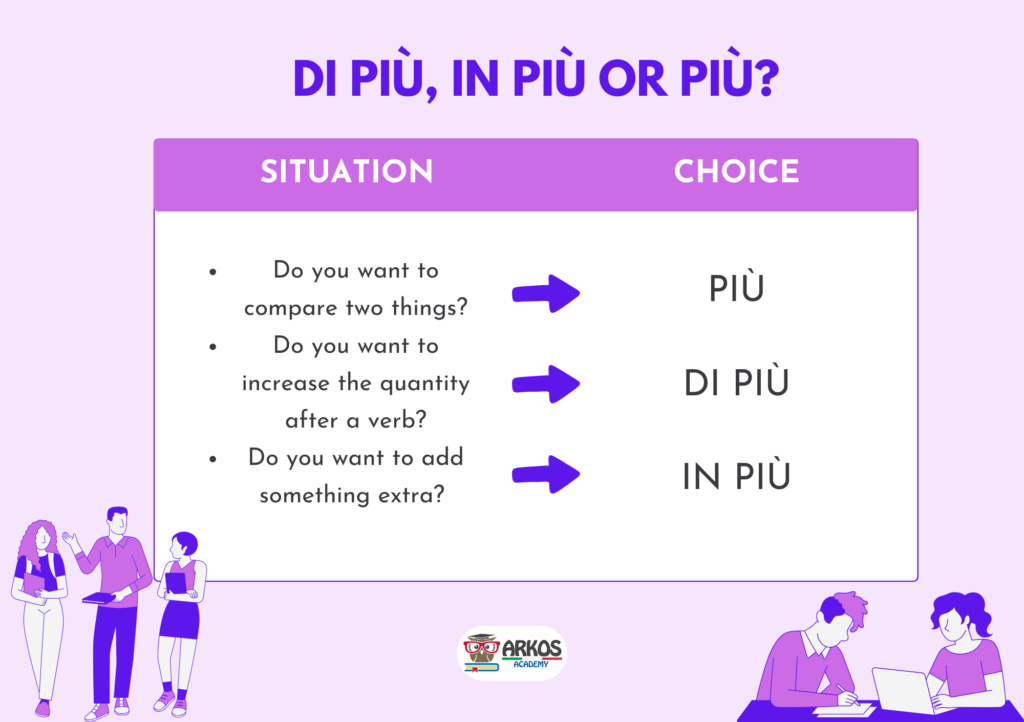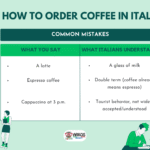Introduction
Understanding the difference between più, di più, and in più is essential for anyone learning Italian. These small but powerful expressions can change the meaning of a sentence, and using them correctly will improve your fluency. In this guide, we’ll explore their distinct uses, provide practical examples, and help you avoid common mistakes.
Italian prepositions and adverbs can be tricky, especially when they appear in different phrases with distinct meanings. One such case is the Italian word PIÙ. Did you know that it can be used in three different ways?
The expressions PIÙ, DI PIÙ, and IN PIÙ have unique grammatical roles and meanings. Understanding their proper use requires paying attention to the context in which they appear. But don’t worry! This guide will clarify everything for you with detailed explanations, examples, and common mistakes to avoid.
If you’re looking for a comprehensive guide on the difference between più, di più, and in più, this article will give you all the tools you need to master them effectively.
PIÙ: The Basic Form
The word più generally expresses a greater quantity or degree compared to something else. It is used in comparatives of superiority and relative superlatives.
1. Comparative of Superiority and relative superlative
It is used to indicate that something is greater in degree, quality, or quantity than something else.
✅ L’italiano è più difficile di quanto pensassi.
(Italian is more difficult than I thought.)
✅ Questo è il posto più bello che abbia mai visto.
(This is the most beautiful place I’ve ever seen.)
2. Mathematical Sign
The word più is also used in mathematics to indicate addition.
✅ Quanto fa 23 + 78?
(What is 23 + 78?)
3. Negative Sentences (No More)
When preceded by non, più expresses the idea of no longer or no more, similar to the English phrase “no more.”
✅ Non voglio più parlarti!
(I don’t want to talk to you anymore!)
This makes più an essential word in everyday Italian, used in various situations, from mathematics to common expressions.
DI PIÙ: Expressing More Intensity or Quantity
The phrase di più is used after verbs to express a greater amount or intensity than before.
✅ Dovresti ascoltare di più l’insegnante durante la lezione.
(You should listen to the teacher more during the lesson.)
Di più vs in più: While di più emphasizes an increase in intensity or quantity, in più often refers to something additional rather than an increase in degree.
Understanding the difference between più, di più, and in più is crucial for anyone learning Italian, as these expressions frequently appear in both spoken and written language.
IN PIÙ: Indicating Addition or Extra Quantity
The phrase in più has two main uses:
1. Expressing Addition (Similar to “Moreover” or “Additionally”)
Used to introduce extra information or an additional point.
✅ Mi ha sbattuto il telefono in faccia e in più mi ha risposto sgarbatamente!
(He slammed the phone in my face, and in addition, he answered me rudely!)
2. Indicating an Extra Amount
Used to specify that something is more than expected or required.
✅ Avevo ordinato tre Coca-Colas, ma il cameriere ne ha portata una in più.
(I had ordered three Coca-Colas, but the waiter brought one extra.)
This distinction is important, especially when forming complex sentences in Italian.
Comparison Table: PIÙ vs. DI PIÙ vs. IN PIÙ
To make these differences clearer, here’s a comparison table:
| Expression | Meaning | Example |
|---|---|---|
| Più | Comparative / Mathematical sign / No more | L’italiano è più difficile di quanto pensassi. Quanto fa 23 + 78? Non voglio più parlarti! |
| Di più | Greater quantity or intensity, usually after verbs | Dovresti ascoltare di più l’insegnante. |
| In più | Addition or extra quantity | Il cameriere ha portato una Coca-Cola in più. |
Other Expressions with “PIÙ”
Besides these three cases, più is found in many common Italian expressions. Here are a few:
- Più o meno (More or less): Il biglietto del museo costa più o meno dieci euro.
- Più che altro (Mostly / More than anything): Ti ho chiamato più che altro per sapere se vieni alla festa.
- Per lo più (Mostly / Generally): Michele va al lavoro per lo più in bici.
- Al più (At most): Carlo? Non è per niente un gran lettore. Al più leggerà tre libri in cinque anni.
Understanding these idiomatic expressions will further enhance your fluency in Italian.
Common Mistakes to Avoid
- ❌ Ho ricevuto una sorpresa di più. (Incorrect)
✅ Ho ricevuto una sorpresa in più. (Correct – Meaning: I received an extra surprise.) - ❌ Voglio più mangiare. (Incorrect)
✅ Voglio mangiare di più. (Correct – Meaning: I want to eat more.)

Many Italian learners struggle with the difference between più, di più, and in più, so recognizing these common mistakes will help you avoid errors in conversation and writing.
Summary
- PIÙ: Used for comparisons, superlatives, mathematics, and negation (no more).
- DI PIÙ: Used after verbs to indicate a greater amount or intensity.
- IN PIÙ: Used for addition or extra quantity.
Now that you understand the difference between più, di più, and in più, try using them in your own sentences!
🎥 Still confused? Watch our video explanation here: Click here to watch
By mastering these distinctions, you’ll improve both your spoken and written Italian. The difference between più, di più, and in più may seem subtle, but once you recognize their unique roles, your language skills will become much more precise and natural.




